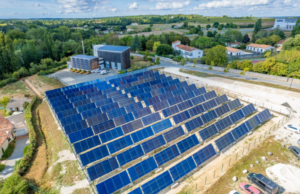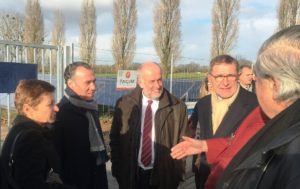France: Solar District Heating with Energy Costs around 0.06 EUR/kWh
December 4, 2012
A new business and housing area in suburban Toulouse in southern France, called Balma-Gramont “eco-district”, will be connected to the country´s first solar-supported district heating network. Special vacuum tube collectors made in France and installed over a parking area are to provide 15 % of the heating in offices, ecologically built houses, shops, small businesses, schools and public utilities. The 300 kW solar field will supply heat to the houses and offer shade to the parking area.
While SAED Sophia Energy is supplying the solar system components and OPPIDEA is installing them, Grand Toulouse acts as the general contractor for the entire district heating system. The customer is Cofely, France’s largest energy service company and a part of the GDF Suez Group.
In addition to the solar system, there will be a wood and a gas boiler installed onsite. The renewable sources (solar and biomass) will provide up to 80 % of the required heat. The main reason for using solar energy is to make the district heating system comply with the Réglementation Thermique 2012, which limits the energy consumption of buildings per m² – but subtracts solar energy share. In summer, the solar system is said to cover 100 % of the buildings’ hot water requirements and the network losses, so that the gas and biomass boiler can be turned off. Moreover, the solar plant makes government grants available to set up the district heating system.
The solar system will supply hot water from April to September and support the heating system during the wintertime. It will use a special large low-cost high-temperature vacuum tube collector system, which was developed by French company Sophia Antipolis Énergie Développement (SAED). Actually, talking about a collector is already misleading: In their collector loop, SAED combines one long manifold header pipe, which is made of simple DN50 steel, with heat pipe vacuum tubes. The head of the heat pipe is more a flat aluminium plate, with three channels running through it and carrying the fluid. This aluminium plate is wrapped around the manifold and attached to a thermal gasket, in order to transfer the heat to the manifold (see the picture above). This leaves the inside of the manifold free of obstacles, which minimises any pressure losses. An SAED standard solar collector loop is 160 m long (80 m in both directions) and contains 2,000 vacuum tubes. The tubes are regular twin-glass vacuum tubes and the pipe is insulated with 90 mm thick rock wool. One collector loop has an approximate nominal power of 100 kW. In case of larger plants, several loops can be installed parallel to each other.
Based on this design, the solar field in Toulouse, which will be assembled in early 2013, will have two solar loops, which are larger than standard size and contain almost 5,000 vacuum tubes. The collector loops will have an aperture area of 444 m² and a nominal power of 300 kWth. According to simulations, the solar yield will be 480 MWh per year, which equals 1,080 kWh/m²*year.
The fluid used in the solar circuit will be normal tap water treated with a mild anti-corrosion product. The fluid will run through a 2 m³ buffer tank to ensure that the temperature of the water fed into the heat exchanger remains constant. There is no auxiliary heat source in the buffer or solar circuit. After passing the buffer, the water will run through a heat exchanger to transfer the heat to the feed line of the district heating network. The required feed line temperature of the district heating grid will be between 55 and 105 °C. It will be a rather low-temperature application for SAED´s collector, which has been designed for high temperatures of up to 130 °C. This will leave room for adjusting the temperature delivered by the solar system to the one present in the district heating grid. While the buffer will only be used to adjust the temperature, there will be two larger tanks of 12 m³ each to store heat in the district heating system.
According to SAED Head of Sales, Olivier Roinson, the collector design results in average costs of as low as EUR 300 per m² of installed collector area. “The solar heat for the Toulouse-Balma project, which is – by the way – our first commercial project, costs around 0.06 EUR/kWh. We plan to cut that in half in the future when our solution gets standardised,” Roinson says.
The interest in solar-supported district heating in France is increasing. In October, the French district heating association AMORCE organised a workshop together with research centre INES and solar engineering office Tecsol to present solar heat to district heating companies, consultants and local authorities. In a survey carried out this summer among district heating companies, 40 out of 100 said they were interested in a pre-feasibility study for solar district heating.
SAED Sophia Energy is also currently working on two other solar district heating projects in France – one in Juvignac (Montpellier) and one in Perpignan – and on others international projects in the EU, the Middle East and North Africa.
More information:
Solar District Heating: http://www.solar-district-heating.eu
SAED: http://www.sophia-energie.com
Cofely GDF SUEZ: http://www.cofely-gdfsuez.com
TECSOL: http://www.tecsol.fr
INES: http://www.ines-solaire.org
AMORCE: http://www.amorce.asso.fr


